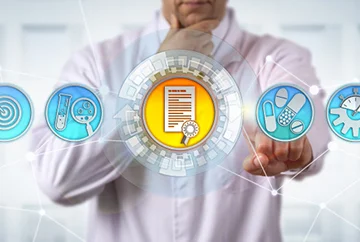However, up until early last year, it could be said that the pharmaceutical industry was relatively slow in adopting and embracing these technologies. Despite having healthcare databases with medical services providers and patient data of more than 300 million in units. At the same time, this delay may be accrued to aspects of regulatory requirements, other industries with similar or even heavier regulations to adhere to have been quick to implement advanced technology at a comparatively faster rate. The banking and financial services industry (BFSI) is a perfect example of this case in point.
AI & Machine Learning in Pharmacovigilance
Why is it Gaining Ground?
With the pandemic affecting every aspect of our lives, stakeholders in the biopharma industry and pharmaceutical companies were quick to realize that the time to unlock the capabilities of technology within their sphere of work had come. It was time to embrace automation and take massive strides in expanding operational potential.
While there had been some automation experiments in the pharmaceutical industry, most of them were limited to robotic process automation (RPA) in ops maintenance and patient servicing chatbots. Burdened by legacy processes of clinical trials in pharmacovigilance and ever-increasing volumes of case processing year-on-year, pharma professionals soon realized the need and scope to leverage artificial intelligence (AI) and machine learning (ML) at scale.
Applying AI & Machine Learning to Case Processing
- Optimized Rapid Delivery and Cross-Industry Collaboration
- Connect Therapeutic Areas to All Strategic Capabilities
- Support Clinical Trial Efficiency, Interoperability, Effectiveness & Feasibility Goals
- Improve Automation and Observability of Regulatory and Safety Systems
- Measure Core Pharma Systems on Consumption and Experience
- Develop Community of IP Practice for Data, Open Source, and Patent Prosecution
- Social Listening for Accurate Health and Drug-Related Information
1. Optimized Rapid Delivery and Cross-Industry Collaboration
A European study on successful drug launches within the EU market closely looks at the benefits of cross-industrial collaboration in pharmacovigilance. New-age technologies enable a collaborative atmosphere enabling optimization of clinical trials and drug testing. To this end, AI and ML help in tearing down silos and automating 50-60% of simple post-marketing cases by using lessons learned in other biopharma studies upon identification of an appropriate opportunity to do so. Collaborative tendencies help standardize data and processes while optimizing signal detection techniques by the effective use of predictive analytics.
2. Connect Therapeutic Areas to All Strategic Capabilities
The pharma industry experiences growing volumes of adverse events (AE) data. The United States Food and Drug Administration (FDA) alone reported a 2.6-fold increase in the number of AE says they received in the eight years between 1998 and 2005. While volume increase is a global phenomenon, there is massive underreporting of AEs. This presents an opportunity to connect therapeutic areas across the world; mining new data sources can potentially unlock strategic capabilities within the pharmacovigilance domain. Intelligent workflow automation and cognitive agents help us reimagine a pharmacovigilance setup primarily focused on research and drug development. Such an end-to-end process overhaul can reduce trial time, eliminate operational bottlenecks, and minimize workflow laggards.
3. Support Clinical Trial Efficiency, Interoperability, Effectiveness & Feasibility Goals
A report by the US National Institutes of Health reveals the impact of emerging tools of AI on the case processing component of pharmacovigilance, which in effect has the most economic impact on its budget. Pharmacovigilance has a massive potential to automate patient safety data and optimize clinical trial efficiency. Technologies such as Signal detection, analyses of large volumes of data, and risk contextualization and tracking, ML-algorithms can be leveraged to achieve this objective. Pharmacovigilance professionals can leverage the combined accuracy measures to adjudicate different vendor algorithms upon successful training of adverse event database content. Automation proves to be an economically feasible and effective strategy since manual dependence on data entry, source document annotation, an otherwise strenuous activity, is eliminated.

Applying AI & Machine Learning to Case Processing




